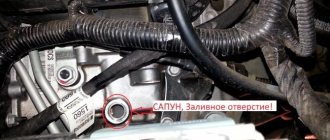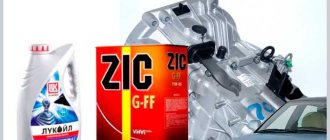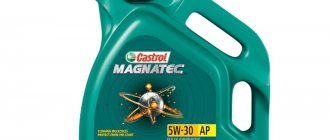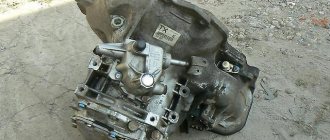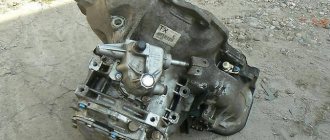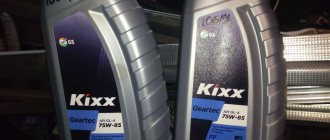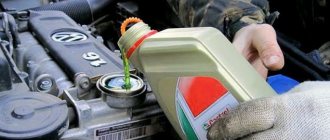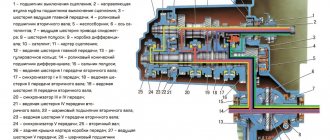Changing the oil in the automatic transmission of a Toyota Camry 50 would seem to not raise questions, but nevertheless, V50 owners have questions and sometimes even dispute them (how many people, so many opinions... the saying is old, but still working, and does not require maintenance) . In order for a car to bring pleasure and avoid problems for a long time, maintenance is necessary, and timely oil changes in an automatic transmission are one of the guarantees for the durability and reliability of the car as a whole.
The main questions about automatic transmission oil: when to fill, what kind of oil to choose, how much to pour, partial or complete replacement?!
According to the regulations, the first oil change in an automatic transmission must take place at 160,000 km, followed by a change every 80,000 km. With a heavily loaded vehicle (for example, additional luggage on the roof of the car or a trailer), the condition of the oil must be checked every 40,000 km or 2 years (replace if necessary), with a mandatory replacement every 80,000 km.
But the reality among the majority of Toyota Camry owners is slightly different, each has their own driving style and a different amount of knowledge about transmission maintenance, and for owners with minimal technical education (at the level of understanding the need for maintenance), questions arise only after problems begin with the transmission: jerking , kicking, slow gear shifting, slipping, dips, whistling (although the latter appears mainly after an oil change).
If the car has a mileage of more than 100,000 km, without changing the oil in the automatic transmission and showing any problems, the oil still needs to be changed, since over time it loses its properties and becomes clogged with wear products. To make sure it is worth changing or not, check the condition and color of the oil: to do this, drain 50 grams of oil from the pan, and if it is black/dark, you need to change it, and preferably at the same time as the filter; if the oil is pink/red, you can postpone the replacement for now. But don’t forget, the sooner you start changing the oil, the better for the box
In this article, the information concerns automatic transmissions installed on the entire Camry XV50 model range, except for modifications with a hybrid power plant:
- Camry 2.0 (6AR) ASV51 with 4-speed automatic transmission Aisin U241E;
- Camry 2.5 (2AR) ASV50 with 6-speed automatic transmission Aisin U760E;
- Camry 3.5 V6 (2GR) GSV50 with 6-speed U660E from the same manufacturer Aisin;
What kind of oil to pour
It is recommended to use automatic transmission oil in Camry 50 from Toyota: branded WS fluid for automatic transmissions - Toyota Genuine ATF WS (number 08886-02305, 4-liter canister) or Idemitsu ATF Type-TLS-LV (number 10114042B). Idemitsu transmission oil is specially designed for use in automatic transmissions of passenger cars and SUVs of the Toyota, Lexus and Scion brands, where the use of a fluid with Toyota ATF WS approval is required (automatic transmission manufacturer specification - JWS 3324). The oil manufacturer does not recommend the use of this lubricant in automatic transmissions, where any other original manufacturer specifications are recommended.
Toyota ATF WS and Idemitsu ATF Type-TLS-LV are the best oils for the Toyota Camry V50 automatic transmission.
For those who, for personal reasons, do not want to pour Toyota oil as an alternative, we recommend paying attention to analogues. These oils have proven themselves well and have received quite a lot of positive reviews and recommendations - TOTACHI ATF WS, Anisin ATF Wide Range AFW and AMSOIL Signature Series Fuel-Efficient Synthetic ATF.
When choosing an oil, the main thing is not to buy a fake, so initially think carefully about where it is best and most reliable in your region to purchase original oil and filter from one manufacturer or another.
Classification of original Toyota gear oil
produces transmission oils that have two systematized lists in accordance with international standards - SAE and API, which are suitable for modern gearboxes. All fluids contain these tolerances.
SAE classification
Lubricants are classified according to the SAE standard, but are understood as SAE J306. This sample sets the viscosity of liquids on one scale. For example, it can be represented by the single number 80, or there will be the letter W next to the number. Typically, many oil viscosity parameters are designated by two data.
| SAE standard | Kinematic viscosity at +100 °C | Temperature Range |
| 85W-90 | 11 | Universal |
| 15W-50 | 5.6 | Universal |
| 85W-140 | 11 | Universal |
| 75W-140 | 4.1 | Universal |
| 15W-40 | 5.6 | Universal |
| 80W-140 | 7 | Universal |
| 80W-85 | 7 | Universal |
| 15W-30 | 5.6 | Universal |
| 75W-85 | 4.1 | Universal |
| 80W-90 | 7 | Universal |
| 75W-80 | 4.1 | Universal |
| 75W-90 | 4.1 | Universal |
| 20W-30 | 5.6 | Universal |
| 20W-20 | 5.6 | Universal |
| 10W-40 | 4.1 | Universal |
| 5W-60 | 3.8 | Universal |
| 10W-60 | 4.1 | Universal |
| 5W-30 | 3.8 | Universal |
| 20W-40 | 5.6 | Universal |
| 0W-20 | 3.8 | Universal |
API classification
These lubricant viscosity parameters were developed by the American Petroleum Institute. The classification of Toyota transmission oils with brief explanations is presented in the table:
| API standard | Status | Year of issue |
| GL-3+ | No information | Current standard |
| GL-1 | No information | Current standard |
| GL-4+ | 1995 | Current standard |
| MT-1 | No information | Current standard |
| GL-2 | No information | Current standard |
| GL-4 | 1995 | Current standard |
| GL-6 | No information | Current standard |
| GL-3 | No information | Current standard |
| GL-5 | 1995 | Current standard |
| GL-5 LS | 1995 | Current standard |
When to change
How often and after what mileage is it better to pour?! At this stage it is possible to go in two ways:
- pour according to regulations. But, with frequent loads, be ready to repair the gearbox after 100,000 km, or even earlier. Of course, it is possible to sell the car before the first symptoms of future problems appear, but believe me, you will not lose if you change the oil more often, and over time the car will be sold at a higher price based on its technical condition, and as a result, both parties will get what they want;
- as has already become clear from the previous paragraph, it is better to change the oil in the Camry V50 gearbox more often, drive with a moderate frequency of loads and forget for a long time about the existence of potential problems in the Toyota transmission;
How to choose Toyota transmission oil
You need to choose the fluid for your car carefully. First you need to understand what kind of lubricant is right for you. Also decide what additives your car needs. If you choose them correctly, the performance of the mechanisms will improve and the service life will increase.
Let's highlight those that are most popular:
- Anti-oxidation and rust . With the help of this additive, the lubricant protects all internal elements of the gearbox from premature wear. In addition, the composition does not produce foam. Toyota transmission oil helps to avoid heavy loads even at high speeds.
- Impact protection . Without exception, all lubricants contain additives that help create a dense layer on the surface of the mechanisms. Temperature changes do not in any way affect the chemical components of such additives. They also protect against rapid wear and corrosion.
- Mixed additives . Considerable attention is paid to the quality of liquids. Due to fatty synthetic additives, the lubricating properties of the film are improved. As a result, all mechanisms are under reliable protection from various unfavorable factors.
Partial or complete replacement
In the Camry 50 gearboxes, just like in the previous body equipped with the same gearboxes, the oil can be changed completely or partially.
A partial oil change in an automatic transmission is done in a simple way: as much as the old one is drained, the same amount of new oil is poured in (about 2-2.5 liters are drained).
A partial replacement is done at a mileage of 40,000 km, then the oil is partially changed after another 40,000 km, after which, at a mileage of 100,000 km, a complete oil change is done using an installation.
During a partial replacement, the automatic transmission oil can be changed without a filter
A complete replacement, as mentioned above, is done with a special apparatus. Hardware replacement occurs by replacing old oil with new oil, washing away wear products. A complete replacement will require from 10 to 16 liters of oil, depending on the condition of the lubricant.
A complete oil change can be done with or without changing the oil filter. But it is recommended to change the filter if the mileage is high or the filter was not changed during partial replacement. It is also necessary to wash the pan.
An important factor is the engine hours, so if the car is used mainly in the city (traffic jams), then it is better to carry out a partial replacement every 30,000 km, and a complete replacement after 60,000.
HOW WE CHECK
We measured the main physical and chemical indicators - viscosity and viscosity index, flash point and pour point - in a certified laboratory. Friction and wear losses were assessed using a friction machine, a device that simulates the operating conditions of various friction pairs. The tests were carried out in two stages. At the first, a model similar to a gear was studied. At the second stage, operating conditions in bearings were simulated. At the same time, friction coefficients, oil heating, and wear of friction pairs were measured. Wear was determined by accurately weighing the parts before and after the test cycle, and for the bearing model - also by the hole method. This is when, before testing, a hole of a fixed size is cut on the working surface of the sample, in the area most susceptible to wear, and at the end of the tests, the change in its diameter is recorded. The more it increases, the higher the wear.
Tests for each fluid at one and the other stages lasted a long time: one hundred thousand load cycles for the bearing model and fifty thousand for the gear model.
TOTAL
If during traditional examinations of gasoline and motor oils we, as a rule, identified only minor differences between one sample and another, here the situation is different. In terms of key parameters, the difference between different ATFs turned out to be significant. And if you consider that the degree of influence of this complex fluid on power, fuel consumption, and the resource of the box is very noticeable, then you should think about its choice. Good synthetics with a high viscosity index are the best choice, which will protect your nerves during winter starting in fairly cold weather, and will not create problems after a long stay in a traffic jam under the sultry sun.
The extent to which Multi matches its name will be left to the conscience of its developers. At the very beginning, we noted that it is unrealistic to test in practice every ATF in all the “machines” listed on their labels. By the way, in the descriptions (with a few exceptions) tolerances are either directly or by default designated by the word meets, that is, “corresponds.” This means that the properties of the liquid are guaranteed by its manufacturer, but there is no confirmation of compliance by the manufacturer of the car or box. In conclusion, we would like to inform you that if the planned service life of a new car does not exceed 50–70 thousand kilometers (then a replacement is planned), then you read the article in vain - you will not have to change the “liquid clutch”. In other cases, the information we have obtained should be useful. Adding up the results obtained in all tests, we found that the best products were Motul and Mobil, with Formula Shell liquid lagging behind slightly.
Our comments on each drug are in the photo captions.
WHAT ARE THE PROBLEMS?
ATF fluids are very capricious. Modern ATF may not always suit an old machine of the same brand. The same applies to interchangeability: say, an “automatic” from a “Japanese” in 2006 on a specialized ATF, addressed to a modern “German”, may become bad... Lubricating the gears and bearings will be such a hassle, but the torque converter may be offended and go on strike. Therefore, each automatic transmission manufacturer is looking for its own solution to the problem. And the more difficult it is to make a universal “cartoon” that suits everyone.
GINGERBREAKERS GIVEAWAY
So, let's see what happened. It immediately caught my eye that the effect of the fluid brand on the friction coefficient was very ambiguous. For the gearing model, all differences were within the measurement error limits. The Dutch NGN Universal ATF looks a little better than others. But for the bearing model everything is different - the range of the measured parameter is quite large. The best performance here is found in Motul Multi ATF and Castrol ATF Multivehicle fluids.
How critical is the difference in this parameter? On the scale of the entire power unit (engine and gearbox), the share of friction losses in the box is not so large (if you do not take into account losses in the torque converter). But the heating of the oil from friction when operating on different fluids varies much more significantly: the average cumulative difference for the gear and bearing models is approximately 17%. From the point of view of the temperature effect, this difference is very noticeable - up to 10–15 degrees, which gives a change in the efficiency of the torque converter by a noticeable few percent. Motul synthetics look better than others here. NGN Universal and Totachi Multi-Vehicle ATF fluids are only slightly inferior to it.
Heating a liquid also affects its viscosity: the greater the heating, the lower it is. And with a drop in viscosity, the efficiency of the torque converter decreases. Many people remember problems with the “automatic machines” of not very young “French” cars, when due to the increase in fluid temperature (especially in summer in traffic jams) they refused to work at all!
Go ahead. It is very important that the dependence of viscosity on temperature is as flat as possible. One of the main criteria for this flatness is the viscosity index: the higher it is, the better. The leaders here are Mobil Multi-Vehicle ATF, Motul Multi ATF and Formula Shell Multi-Vehicle ATF. The “cartoon” of the NGN brand was not far behind them.
Let's see how much the viscosity of the liquid in the working area of the box changes, taking into account its heating. The difference is noticeable! For kinematic viscosity it reaches 26%. And the efficiency of “automatic machines” (especially older designs) is quite low and is largely determined by the efficiency of the torque converter - which is precisely what suffers when the viscosity of the working fluid decreases.
The smallest drop in viscosity was found for Motul Multi ATF, Formula Shell Multi-Vehicle and NGN Universal ATF oils. The highest is with Totachi Multi-Vehicle ATF. These are, of course, comparative results; direct transfer to the efficiency of the box cannot be made. But for forced engines, in which the load on the automatic transmission components is higher, it is preferable to have fluids with more stable characteristics.
Low-temperature properties were assessed using a combination of several parameters. Obviously, all liquids, including ATF, thicken in the cold. This means that with a significant minus overboard, excessive viscosity will interfere with cranking the engine at the start, since cars with automatic transmissions do not have a clutch pedal. Therefore, we determined the kinematic viscosity of each sample at three fixed negative temperatures. In addition, we estimated the temperature at which the kinematic viscosity of the oil will reach a certain fixed value, conventionally accepted as the limit at which it is still possible to “crank” the gearbox.
At the same time, they determined the freezing point: this parameter is included in all descriptions of ATF and indirectly indicates on what basis the liquid is made - synthetic or semi-synthetic.
Synthetics with a high viscosity index again won in this category: Motul Multi ATF, Mobil Multi-Vehicle ATF, NGN Universal ATF, Formula Shell Multi-Vehicle. They also recorded the lowest pour temperatures. And finally, the protective functions of liquids, that is, their ability to prevent wear. We examined the wear of two models - gearing and sliding bearings, since in a real gearbox the operating conditions of these units differ markedly. Consequently, the properties of ATF, which reduce wear, must be different and linked to the operation of the torque converter. And here we found a scattering of results. The leader in minimizing gear wear is Mobil Multi-Vehicle ATF, and in the plain bearing competition, Motul Multi ATF and Totachi Multi-Vehicle ATF won by a wide margin.
ATF - LIQUID OR OIL?
The classification classifies ATF as transmission oils, but its purpose is much broader. After all, lubrication of transmission elements - gears and bearings - is not the only (albeit important) function here. The main thing is that ATF acts as the working fluid of the torque converter. It is this fluid that transmits the flow of power from the engine to the transmission, therefore the properties of this fluid are very important for the efficiency of the automatic transmission.
ATF passports standardize its viscosity (at operating temperatures and at negative temperatures), as well as its flash point and pour point, and its ability to form foam during operation. After all, it is viscosity that ensures lubrication and, therefore, the performance of gears and bearings, and the efficiency of transmitting torque from the engine to the transmission.
